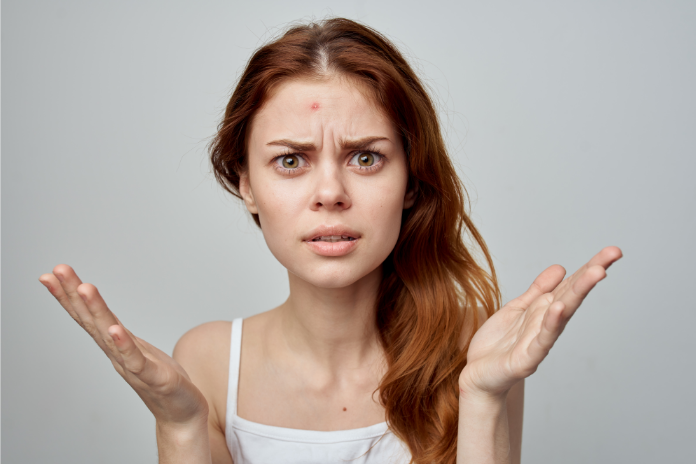Teen acne is common during teenage life due to puberty and hormonal changes. Acne that appears on the face can affect self-esteem and over time may cause permanent physical scarring. It can also cause emotional distress. There are many effective treatments for acne that reduce both the number of pimples and the chance of scarring.
What is teen acne?
The skin has several tiny holes known as pores which are blocked by oil, bacteria, dead skin cells, and dirt. When this occurs, pimples may develop and if the skin is repeatedly affected by this condition then it is called acne.
Acne can occur almost anywhere on the body and most commonly on the face, back, neck, chest, and shoulders. These are typically white and black in color. Both whiteheads and blackheads are known as comedones.
Types of acne
- Whiteheads
- Blackheads
- Papules
- Pustules
- Nodules
- Cysts
Causes of teenage acne
Acne occurs when the pores of the skin get blocked with oil, dead skin, or bacteria. Each pore of the skin opens up to a follicle. The follicle is made up of hair and an oil (sebaceous) gland. The oil gland releases oil (sebum) which travels up the hair, out of the pore, and onto the skin. The sebum keeps the skin lubricated and soft. One or more problems in this lubrication process can lead to acne. It can occur when –
- Too much oil is produced by the follicles
- Dead skin cells accumulate in the pores
- Bacteria build up in the pores
These problems contribute to the development of pimples. A pimple appears when there is bacterial growth in a clogged pore and the oil is unable to escape.
Treatment for existing acne
At-home care
- Cleaning the skin on daily basis with a mild soap (avoid irritant soap) to remove excess oil and dirt
- Shampooing the hair on regular basis and keeping it out of the face
- Using makeup that’s water-based or labeled not pore-clogging
- Do not squeeze or pick pimples that spread bacteria and excess oil
- Not wearing hats or tight headbands
- Don’t touch the face
Medication
- Benzoyl peroxide is available in many acne creams and gels. It helps in drying out existing pimples and preventing new ones. Benzoyl peroxide also kills acne-causing bacteria.
- Sulfur is a natural ingredient with a property of distinctive smell that’s found in some lotions, cleansers, and masks.
- Resorcinol is a less common ingredient used in removing dead skin cells.
- Salicylic acid is often used in soaps and acne washes. It helps prevent pores from getting plugged.
Other treatment –
- Oral and topical antibiotics reduce inflammation and kill the bacteria which cause pimples. Typically, antibiotics are only used for a short time so that the body doesn’t build up a resistance and leave prone to infections.
- Prescription topical creams like retinoic acid or prescription-strength benzoyl peroxide are often stronger than over-the-counter treatments. These work to reduce oil production. Benzoyl peroxide acts as a bactericidal agent that prevents the resistance of acne-causing bacteria to antibiotics. It also has moderate someone destroying and anti-inflammatory properties.
- Photodynamic therapy uses medication and a special light or laser which help in reducing oil production and bacteria. Other lasers can also be used alone to help improve acne or scarring.
- Dermabrasion removes the top layers of the skin with a rotating brush and would be best for treating acne scarring as opposed to a treatment for acne. Microdermabrasion is a milder treatment that helps remove dead skin cells.
- A chemical peel helps in removing the top layers of the skin. That skin peels off to reveal less damaged skin underneath. Chemical peels can improve mild acne scarring.
- The doctor may suggest using cortisone injections if the acne consists of large cysts. Cortisone is a steroid naturally produced by the body which can reduce inflammation and speed healing. It is usually used along with other acne treatments.
How to prevent teen acne?
Yes, it can be prevented and steps include –
- Washing the face twice a day with an oil-free cleanser
- Use over-the-counter acne cream for removing excess oil
- Avoiding makeup that contains oil
- Removing makeup and cleansing the skin thoroughly before bed
- Showering after exercising
- Avoiding tight-fitting clothing
- Eating a healthy diet with minimal refined sugars
- Reducing stress
When to see a doctor?
If there are symptoms of acne, the doctor can make a diagnosis by examining the skin. The doctor will identify the types of lesions and the severity to determine the best treatment.
Conclusion
Acne is the most common skin condition and isn’t a life-threatening condition, it can be painful particularly when it’s severe. But no need to worry as it is common and can be prevented. If acne is many then consult the doctor for treatment.
References –
- teen acne: causes, symptoms, treatments, & more (webmd.com)
- why do I get acne? (for teens) – nemours kidshealth
